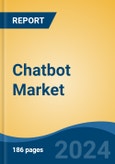Retail & eCommerce is the fastest growing segment, Asia-Pacific is the largest market globally
Speak directly to the analyst to clarify any post sales queries you may have.
10% Free customizationThis report comes with 10% free customization, enabling you to add data that meets your specific business needs.
Key Market Drivers
The continuous advancements in Artificial Intelligence and Natural Language Processing serve as a primary driver for the global chatbot market. Continuous improvements in AI algorithms and deep learning models enable chatbots to understand complex human queries and generate coherent, contextually relevant responses with greater accuracy. These technological enhancements expand chatbot functionality, moving beyond basic inquiries to sophisticated interactions that closely emulate human conversation, thereby increasing their utility across diverse enterprise applications.Key Market Challenges
The inherent concern regarding data privacy significantly impedes the expansion of the global chatbot market. Consumers are increasingly hesitant to engage with automated systems that may collect, process, and store their personal information, particularly sensitive data. This apprehension erodes user trust, which is fundamental for widespread adoption and sustained interaction with chatbot services. According to the International Association of Privacy Professionals (IAPP), in 2023, 68% of consumers globally expressed concern about their online privacy, with 57% specifically identifying artificial intelligence as a significant threat to their privacy.Key Market Trends
The Global Chatbot Market is significantly shaped by the increasing integration of multimodal artificial intelligence, which allows chatbots to move beyond text-only interactions. This trend focuses on processing and combining various data types, including text, voice, images, and video, to create more comprehensive and intuitive user experiences. Multimodal AI enables chatbots to understand complex queries presented through diverse inputs, leading to more effective communication and problem resolution. For instance, according to a Google Cloud announcement in October 2025, Gemini Enterprise launched with next-generation conversational AI agents that can be deployed across telephony, web, mobile, email, and chat in over 40 languages, demonstrating a clear move towards integrating multiple communication modalities. This advanced capability enhances the chatbot's ability to interpret nuanced user intent and respond contextually, thereby increasing overall user satisfaction and expanding the range of applications for chatbots across industriesKey Market Players Profiled:
- IBM Corporation
- eGain Corporation
- Nuance Communications Inc. (Microsoft Corp.)
- Creative Virtual Ltd
- Avaamo Inc.
- EdgeVerve Systems Limited
- Zendesk Inc.
- Inbenta Holdings Inc.
- Serviceaide Inc.
- Amelia US LLC (Ipsoft Inc.)
Report Scope:
In this report, the Global Chatbot Market has been segmented into the following categories:By Bot Communication:
- Text
- Audio
- Video
By End User Vertical:
- Retail & eCommerce
- Healthcare & Life Sciences
By Region:
- North America
- Europe
- Asia Pacific
- South America
- Middle East & Africa
Competitive Landscape
Company Profiles: Detailed analysis of the major companies present in the Global Chatbot Market.Available Customizations:
With the given market data, the publisher offers customizations according to a company's specific needs. The following customization options are available for the report:- Detailed analysis and profiling of additional market players (up to five).
This product will be delivered within 1-3 business days.
Table of Contents
Companies Mentioned
- IBM Corporation
- eGain Corporation
- Nuance Communications Inc. (Microsoft Corp.)
- Creative Virtual Ltd
- Avaamo Inc.
- EdgeVerve Systems Limited
- Zendesk Inc.
- Inbenta Holdings Inc.
- Serviceaide Inc.
- Amelia US LLC (Ipsoft Inc.)
Table Information
| Report Attribute | Details |
|---|---|
| No. of Pages | 186 |
| Published | November 2025 |
| Forecast Period | 2024 - 2030 |
| Estimated Market Value ( USD | $ 6.16 Billion |
| Forecasted Market Value ( USD | $ 23.61 Billion |
| Compound Annual Growth Rate | 25.1% |
| Regions Covered | Global |
| No. of Companies Mentioned | 10 |









